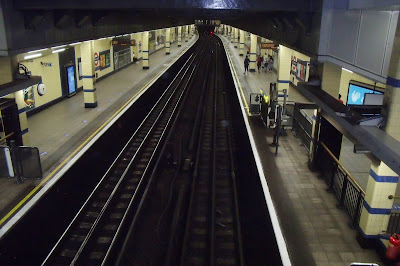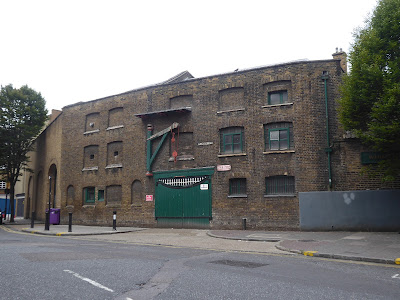Aldgate East is the 19th station on the District Line travelling westwards. The station also services the Hammersmith and City line and is the last of the stations on that line for me to visit.
There are four entrances/exits to the station with two on each side of Whitechapel High Street.
I exited the station onto Whitechapel High Street and then turned left onto Commercial Street. Just back from the road is this building which looks more medieval than Victorian.

This is Toynbee Hall, named after Arnold Toynbee who helped the poor of the East End. It was built in 1884 and was set up so that University students and graduates could come and help to educate local people to give them a chance to escape the poverty and crime that was so prevalent in the area. In his early career Clement Atlee had been a secretary here before going on to be mayor of Stepney and then Prime Minister from 1945-51.

Next to the hall is an arts centre and café with this clock alongside. Due to Covid restrictions it was closed.

You can just about see the inscription above the arch: Erected by the Four Per Cent Industrial Dwellings Company.
I continued along Wentworth Street to where Brick Lane joins Osborne Street. This arch was erected in 1997 as an entrance to what is now known as 'Bangla Town'. This is home to numerous curry houses and a large Sunday morning market.
|
|
Also on Old Castle Street is the front wall of the Wash Houses erected in 1846. A number of public bath houses were built in this area to compensate for the lack of washing facilities in people's homes. These Victorian baths have now been transformed into an events venue for the London Metropolitan University. Also housed there are some of the University's special library collections.
Back on Whitechapel High Street is the White Hart Inn.

There are numerous references to Jack the Ripper in Whitechapel and numerous guided walks. People seem to be fascinated by the horrific details of the unsolved murders.

Next to the pub is this alleyway which has been tiled with a map of the area. It was designed by a local school as part of the Bethnal Green City Challenge. It brightens up what would otherwise be a very dark alleyway.


Next to the alleyway is a shop with this sign above which refers to the building's previous life when it was occupied by the Jewish Daily Post, a short lived daily newspaper. The building is now a 'vape' shop. The building is Grade II listed because of the sign. Apparently there is another one of historical interest inside the building but not accessible to the public.
| A little further on is the Whitechapel Art Gallery. |

The building opened in 1901 with the aim of bringing contemporary art to the people of East London. It has held some impressive exhibitions here such as Picasso's Guernica on its only time in Britain. It has also shown the works of Jackson Pollack, David Hockney and Gilbert and George.

The frieze of golden leaves decorating the art gallery were designed by sculptor Rachel Whiteread and entitled 'The Tree of Life'. The artist has lived in the area for 25 years and was the first woman to win the Turner Prize in 1993. This piece of artwork was commissioned for the London 2012 Festival as part of the Cultural Olympiad.

In 2009 the gallery expanded and took over the neighbouring building, the former Passmore Edwards Library which was opened ten years earlier than the gallery in 1892.The building also incorporates the eastern entrance to Aldgate East station.

Above the building is this unusual weathervane. In the original plans for the Whitechapel Library there was provision for a weathervane but this never materialised. Now, over a hundred years later in 2009, a weathervane has been added. This is not just any old weathervane but one designed by Rodney Graham, a Canadian artist, sculptor and musician. It features Graham himself as the 16th century Erasmus sitting backwards on the horse reading a copy of Erasmus's best known work ' The Praise of Folly'. The 16th C scholar is said to have composed the book on a journey by horseback from Italy to England. The work is a satirical attack on superstitions and traditions in European society.
A more modern sense of humour is to be found with local shop names. This one is a fish and chip shop. There is another similarly named barber's shop close by called, yes you've guessed - Jack the Clipper.

Across the road on the corner of Whitechurch Lane is this old fountain. It was part of the old church of St Mary Matfelon.
 The first church built on this site in the mid 13th century was a chapel of ease (a chapel built within the parish for those who cannot easily travel to the main parish church). Built of Kentish chalk rubble it was known as the 'White Chapel' which gave its name to the local area. In 1329 the chapel was rebuilt as St Mary Matfelon. In the mid 17th century St Mary's church is rebuilt in red brick in a neo-classical roman. In 1875 it is rebuilt again, this time in the Gothic style. But just five years later it is damaged by fire and has to be rebuilt once again. During WW2 it is hit by an incendiary bomb and becomes an unofficial playground and home for vagrants. Twelve years later the derelict church tower is struck by lightning and the building is demolished. In 1966 the former St Mary's churchyard is opened as a municipal garden. You can still see some of the gravestones around the edge of the park.
The first church built on this site in the mid 13th century was a chapel of ease (a chapel built within the parish for those who cannot easily travel to the main parish church). Built of Kentish chalk rubble it was known as the 'White Chapel' which gave its name to the local area. In 1329 the chapel was rebuilt as St Mary Matfelon. In the mid 17th century St Mary's church is rebuilt in red brick in a neo-classical roman. In 1875 it is rebuilt again, this time in the Gothic style. But just five years later it is damaged by fire and has to be rebuilt once again. During WW2 it is hit by an incendiary bomb and becomes an unofficial playground and home for vagrants. Twelve years later the derelict church tower is struck by lightning and the building is demolished. In 1966 the former St Mary's churchyard is opened as a municipal garden. You can still see some of the gravestones around the edge of the park.

In 1994 this park was dedicated to the memory of Altab Ali, the 25 yr old Bengali murdered in Adler Street on 4th May 1978 in a racist attack by three teenage boys. The murder took place on the night of the local elections where the far right National Front party was standing for election in 43 seats, far more than they ever had previously. Even though they polled poorly, their involvement provoked a highly charged atmosphere.
Altab Ali's murder highlighted the general level of racist violence at that time endemic across the borough of Tower Hamlets and beyond. His death marked a turning point. Ten days later on 14th May, about 7000 people marched from the site of his death to Hyde Park to mourn him and to demand police protection. Within the year, after a campaign of sit-down protests locally the National Front, whose headquarters were not far from Brick Lane, was forced out of the area. The Bengali youth movement, which led the Battle for 'Brick Lane', the Anti Nazi League and Rock against Racism groups were born out of the events of 1978 and far right extremists suffered a huge setback.

In 1999 the Shaheed Minar Monument was built to commemorate the Bengali Language martyrs. (On 21st February 1952 students from the University of Dhaka staged a nationwide protest against accepting Urdu as the nation's official language. The peaceful protest led to the loss of several lives.) In recognition of their struggle UNESCO declared the 21st February as 'International Mother Language Day'.
At the entrance to the park is a wrought iron arch created by David Peterson, as a memorial to Altab Ali and other victims of racist attacks. He has used Bengali motifs and the arch is attached to two stones from the original church to marry the two cultures together.
Overlooking the park is St Boniface's German RC church built in the 1950s replacing the previous 19th century church.
The design of the bell tower is unusual but I believe this was the only design that would work to house the original 19th century bells.Whitechapel Bell Foundry Ltd announces, with regret, that by May 2017 it will cease its activities at the Whitechapel Road site.
The Foundry was listed in the Guinness Book of records as Britain's oldest manufacturing company, having been in continuous business since it was established in 1570. Just before it closed I was able to get on one of the last tours of the foundry. It is a step back in time as the bells were made by the same method as in previous centuries. Read about the tour here.
Some of the most famous bells cast here include the original Liberty Bell (Philadelphia), the Great Bell of Montreal and, of course, Big Ben at the Palace of Westminster. Big Ben is the largest bell cast at this foundry weighing over 13 tons.
Unfortunately planning permission has been granted by Tower Hamlets to turn this historic building into a boutique hotel. However, after much opposition from local people, the Minister for planning has stepped in and asked for an enquiry into the building's future. To date no decision has been made.
The next eighteen stations on the District line ar also on the Circle line and as I have already visited them I will now move to West London to continue my exploration of the District Line.






























































